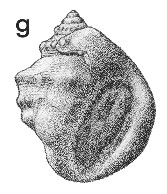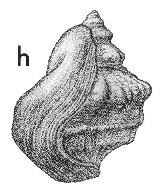
Revised descriptions of New Zealand Cenozoic Mollusca from Beu and Maxwell (1990)

 | Revised descriptions of New Zealand Cenozoic Mollusca from Beu and Maxwell (1990) | 
|
  (Pl. 2g): GS1494, M46/f9500, Wangaloa, Wangaloan (GNS) |
  (Pl. 2h): GS1494, M46/f9500, Wangaloa, Wangaloan (GNS) |
Beu & Maxwell (1990): Chapter 5; p. 81; pl. 2 g, h.
Synonymy: Pugnellus australis Marshall 1916b, p. 120
Classification: Struthiolariidae
Description: Size moderate for family (height 40-50 mm). Protoconch not known; teleoconch of about 5 whorls, strongly shouldered near middle on spire, last whorl with 2 additional, less pronounced angulations or keels. Axial sculpture of prominent nodules on shoulder angulation, only slightly extended abapically on last whorl where they probably number about 20 (uncertain because of obscuring callus). Lower keels with more numerous but much weaker nodules or swellings. Spiral sculpture, other than cinguli marking the lower keels, consisting of fine threads over surface not covered by callus. Aperture rather narrow because of callus, broader adapically and constricted abapically. Columella short, apparently straight, but obscured by callus in adult shells. Apertural callus very prominent, smooth, thickest just below lowest keel where it forms a large swelling, extending well up spire (to apex in some shells), forming a broad, flat varix on the strongly sinuous outer lip.
Comparison: Finlay & Marwick (1937, p. 65) described Conchothyra expedita from Boulder Hill (type locality) and Wangaloa, differentiating it from C. australis on what seem to be minor differences in callus and sculptural characters; it is unlikely to be distinct. C. parasitica Hutton, 1877 (Haumurian (Late Cretaceous),Waipara River; Selwyn Rapids) has callus extending over the back of the shell and completely covering it in adult shells.
Conchothyra is the oldest known member of the Struthiolariidae, a family that is well represented in New Zealand (particularly in the Neogene and modern faunas) and is also present in Australia, the subantarctic islands, Seymour Island and Patagonia. The precise relationship of Conchothyra to the younger members of the family is uncertain, but it is probably significant that Struthiolaria calcar (Pl. 20g, h) and other early species of Struthiolaria have a very similar sculptural plan to C. australis. They differ, however, in having a less extensive callus, a straighter outer lip, and a right-deflected, concave columella.
Distribution: Wangaloan, Wangaloa Formation, Wangaloa (type) (common); Boulder Hill; Broken River (?).
Cite this publication as: "A.G. Beu and J.I. Raine (2009). Revised
descriptions of New Zealand Cenozoic Mollusca from Beu and Maxwell (1990). GNS
Science miscellaneous series no. 27."
© GNS Science, 2009
ISBN
978-0-478-19705-1
ISSN 1177-2441
(Included with a PDF facsimile file
copy of New Zealand Geological Survey Paleontological Bulletin 58 in CD version
from: Publications Officer, GNS Science, P.O. Box 30368 Lower Hutt, New
Zealand)